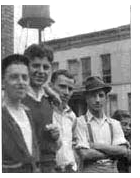| |
During the 1890’s, people from all over Italy were migrating to this country; most left their native land in search of a better life. Many of those who immigrated to Chicago came from southern Italy and settled in an area bounded by Lake Street , Halsted Street , 39th Street , and Lake Michigan.
Nearly all of these Italian immigrants were Catholic. They attended many parishes in the vicinity in which they lived; however, because they did not understand English, they did not feel a sense of connection with the pastors. Many soon began to neglect their religious duties, and even those who continued to attend Mass didn’t feel like part of the congregation.
 Stemming from this need, these immigrants appealed
to the Archdiocese for an Italian priest and a place
of their own in which to worship. The Archdiocese
responded to this request by bringing Reverend Orazio
Mangione to this area from Buffalo , NY . With his
assistance, the parish was founded and a small chapel
opened in the school building of St. John’s Church
on 18th and Clark . The parish was officially founded
on November 26, 1899 .
Stemming from this need, these immigrants appealed
to the Archdiocese for an Italian priest and a place
of their own in which to worship. The Archdiocese
responded to this request by bringing Reverend Orazio
Mangione to this area from Buffalo , NY . With his
assistance, the parish was founded and a small chapel
opened in the school building of St. John’s Church
on 18th and Clark . The parish was officially founded
on November 26, 1899 .
Under the guidance of Fr. Mangione, many Italians returned to church, and soon the parish was officially named after the Patroness of Ricigliano, “Maria SS Incoronata.” The parishioners raised nearly $600 to pay for a statue of the Madonna from Italy , and Mrs. Molly V. O’Neill Cleary acted as the driving force behind the everyday financing of the parish through fundraising and her own personal donations. However, this building soon proved inadequate in terms of location, so Fr. Mangione’s successor, Scalabrini Father Riccardo Lorenzoni, chose the more centralized location of 218 W. Alexander.
The first Mass was celebrated with great fanfare on December 8, 1903 . It began with a procession from the old chapel and included fireworks and two marching bands. The day concluded with Mass celebrated by Fr. Lorenzoni…even though the pews were not yet in place! The cornerstone was laid on August 14, 1904 , with Archbishop Quigley presiding.
|
|